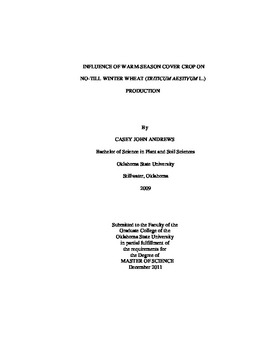| dc.contributor.advisor | Edwards, Jeffrey T. | |
| dc.contributor.author | Andresw, Casey John | |
| dc.date.accessioned | 2014-04-15T22:05:49Z | |
| dc.date.available | 2014-04-15T22:05:49Z | |
| dc.date.issued | 2011-12-01 | |
| dc.identifier.uri | https://hdl.handle.net/11244/9297 | |
| dc.description.abstract | Due to the adverse economic and ecological consequences of the conventional-till, monoculture winter wheat production system that dominates Oklahoma, producers are interested in no-till farming practices and diversifying their cropping systems through crop rotation and cover crops. In response to this interest, we evaluated cover crop biomass production and canopy closure, winter wheat nitrogen requirement, Hessian fly infestation pressure and final wheat grain yield response to warm-season cover crops in no-till, dual-purpose and grain-only wheat production systems. Experimental design was a split split-block with cover crop treatment (cowpea, soybean, guar, sorghum-sudangrass, pearl millet and fallow control) seeded following wheat harvest and chemically terminated approximately 45 days after seeding as whole plots. Sub plot treatment was winter wheat variety (Duster and Endurance) sown into the standing cover crop residue. Sub-sub plots were topdress nitrogen application (non-fertilized or nitrogen rate determined by sensor based nitrogen rate recommendation). During 2009 and 2010, sorghum-sudangrass, pearl millet, and cowpea provided quick biomass and canopy closure, making them well suited for weed suppression and soil erosion prevention. In both dual-purpose and grain-only production systems, wheat productivity following fallow was equal to or greater than wheat following cover crops in almost all categories. Wheat following legume cover crops, in most cases, had production levels equal to or greater than wheat following grass cover crops; however, cover crops had no effect on Hessian fly infestation. Differences in Hessian fly infestation between resistant (Duster) and susceptible (Endurance) wheat varieties were found. Grain yield was not affected by differences in Hessian fly infestation, as infestation pressure was below the economic injury threshold. The integration of cash crops may be a better solution than cover crops, as producers can achieve many of the same benefits associated with cropping system diversification as seen with cover crops as well as receive economic returns through cash crop production. | |
| dc.format | application/pdf | |
| dc.language | en_US | |
| dc.publisher | Oklahoma State University | |
| dc.rights | Copyright is held by the author who has granted the Oklahoma State University Library the non-exclusive right to share this material in its institutional repository. Contact Digital Library Services at lib-dls@okstate.edu or 405-744-9161 for the permission policy on the use, reproduction or distribution of this material. | |
| dc.title | Influence of Warm-season Cover Crop on No-till Winter Wheat (Triticum Aestivum L.) Production | |
| dc.type | text | |
| dc.contributor.committeeMember | Godsey, Chad B. | |
| dc.contributor.committeeMember | Giles, Kristopher L. | |
| osu.filename | Andrews_okstate_0664M_11873.pdf | |
| osu.college | Agricultural Sciences and Natural Resources | |
| osu.accesstype | Open Access | |
| dc.description.department | Department of Plant and Soil Sciences | |
| dc.type.genre | Thesis | |
| dc.subject.keywords | cover crops | |
| dc.subject.keywords | crop diversity | |
| dc.subject.keywords | crop rotation | |
| dc.subject.keywords | hessian fly | |
| dc.subject.keywords | no-till | |
